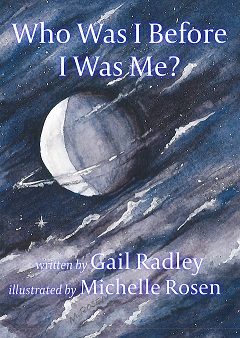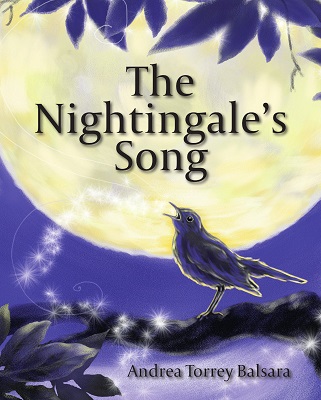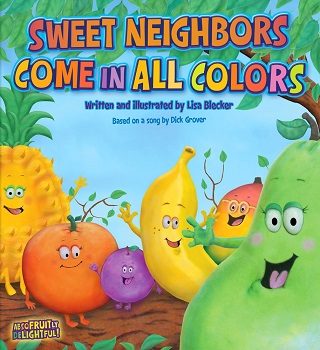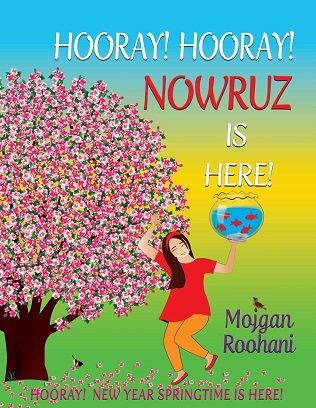State of the Art:
Books for Children
by ALLISON GROVER KHOURY
While scouring the tables in my city’s Bahá’í bookstore for the latest in Bahá’í-inspired children’s books, I came across a few books published in 2018. My reading of the first two left me uncertain, but I brought both books home so I could look at them more thoroughly and set down my thoughts about them.
I was puzzled by the text of Who Was I Before I Was Me? by Gail Radley, but I was also wowed by the soft, expansive illustrations by Michelle Rosen. The book’s back cover bills the text as a poem — an answer to a young child’s question. Several read-throughs later, I still had more questions than answers.
I was puzzled by the text of Who Was I Before I Was Me? by Gail Radley, but I was also wowed by the soft, expansive illustrations by Michelle Rosen. The book’s back cover bills the text as a poem — an answer to a young child’s question. Several read-throughs later, I still had more questions than answers.

Perhaps with poetry, we are more likely to respect and accept the poet’s deeply personal expression. Still, when it comes to a children’s book, I want something more concrete. Is the poem inspired by the kind of wistful look forward so often given by those who dream of having children? Is it an examination of the almost impossible to grasp concept of pre-existence? Or is it a meditation on the relationship between the Creator and the creation?
This book seems to be all three. Heavy reading for young children, but not impossible to understand. And while challenging language can be a good thing when it comes to poetry for adults, finding it here leaves me undecided about whether or not I’d read this book to my children.
Who Was I Before I Was Me? was published by the increasingly diverse and thoughtful One Voice Press in Maryland. Sadly, according to their website, One Voice will close in 2019 and become an imprint of the United States Bahá’í Publishing Trust.
The other book I found on the table in the book store is The Nightingale’s Song by Andrea Torrey Balsara, a Canadian Bahá’í I have known for a number of years. When we first met, her charming book Greenbeard the Pirate Pig (about a pirate guinea pig!) was just about to come out. Andrea is an illustrator who is garnering respect and recognition in the publishing world in Canada. Most recently, she has published The Great and the Small, which is an illustrated novel. The Nightingale’s Song is also published by One Voice Press.
This book seems to be all three. Heavy reading for young children, but not impossible to understand. And while challenging language can be a good thing when it comes to poetry for adults, finding it here leaves me undecided about whether or not I’d read this book to my children.
Who Was I Before I Was Me? was published by the increasingly diverse and thoughtful One Voice Press in Maryland. Sadly, according to their website, One Voice will close in 2019 and become an imprint of the United States Bahá’í Publishing Trust.
The other book I found on the table in the book store is The Nightingale’s Song by Andrea Torrey Balsara, a Canadian Bahá’í I have known for a number of years. When we first met, her charming book Greenbeard the Pirate Pig (about a pirate guinea pig!) was just about to come out. Andrea is an illustrator who is garnering respect and recognition in the publishing world in Canada. Most recently, she has published The Great and the Small, which is an illustrated novel. The Nightingale’s Song is also published by One Voice Press.

The narrator, a middle grade child, awakens from a recurring dream in which their skin color changes and each shade is experienced as beautiful. In the dream, a nightingale sits in a tree just outside the child’s window and sings this refrain: “Brothers and sisters we shall be/ Stars of one heaven, leaves of one tree.”
The book follows the child through other nights with other dreams until the child begins to reflect on the impact of kindness and the meaning of inclusivity. This is a very gentle piece. The repetition is soothing and the language accessible to young children. Torrey Balsara’s book is a good starting place for a discussion about the oneness of humanity and the beauty of all skin colors, as well as for a conversation about the harmful effects of racism and discrimination on both perpetrators and recipients.
The illustrations in the book are dreamy with a tiny bit of sparkle, and they have just the right hint of color for the night time setting. By the light of dawn, which comes at the end of the book, life lessons become clearer and the book concludes on the hopeful note that “Brothers and sisters we shall be!/ We are the colours of humanity./ Like flowers of one meadow/ like leaves of one tree/ We sing together you and me!”
The book follows the child through other nights with other dreams until the child begins to reflect on the impact of kindness and the meaning of inclusivity. This is a very gentle piece. The repetition is soothing and the language accessible to young children. Torrey Balsara’s book is a good starting place for a discussion about the oneness of humanity and the beauty of all skin colors, as well as for a conversation about the harmful effects of racism and discrimination on both perpetrators and recipients.
The illustrations in the book are dreamy with a tiny bit of sparkle, and they have just the right hint of color for the night time setting. By the light of dawn, which comes at the end of the book, life lessons become clearer and the book concludes on the hopeful note that “Brothers and sisters we shall be!/ We are the colours of humanity./ Like flowers of one meadow/ like leaves of one tree/ We sing together you and me!”

A third book that caught my attention this past year was inspired by a song that my own dear father, Dick Grover, wrote in the 1960s called “Good Neighbors Come in All Colors.” Inspired by a bumper sticker he saw on a car while driving from Cape Cod to Green Acre Bahá’í School in Southern Maine, the whole song was written on the three hour trip. A few years ago, Dad was approached by our friend Lisa Blecker about adapting the song for young children, using the metaphor of fruits at a farmer’s market, with the title “Sweet Neighbors Come in All Colors.” Dad immediately said yes to the project. The book came out in September, just before his passing.
Lisa Blecker, who is also the author/illustrator of the very excellent The Good In Me From A to Z, an alphabet/virtues exploration with Dottie the rhinoceros, among other lovely children’s books, has adapted the song and text of “Good Neighbors Come in All Colors” so that they communicate the same message as the original song does about inclusion, friendliness, and kindness while, at the same time, teaching very young children about shapes, sizes and feelings.
The bright, colorful, cheery illustrations are just right for young children. The music for the song is included with the book, along with a website that has a link to a song video and coloring pages (sweetneighbors.org). Lisa and her husband, artist Aaron Kreader, have had a presence in social media recently for their attendance at puppet shows based on Sweet Neighbors and performed by participants in Bahá’í children’s classes. I think Dad would have loved it all.
Lisa Blecker, who is also the author/illustrator of the very excellent The Good In Me From A to Z, an alphabet/virtues exploration with Dottie the rhinoceros, among other lovely children’s books, has adapted the song and text of “Good Neighbors Come in All Colors” so that they communicate the same message as the original song does about inclusion, friendliness, and kindness while, at the same time, teaching very young children about shapes, sizes and feelings.
The bright, colorful, cheery illustrations are just right for young children. The music for the song is included with the book, along with a website that has a link to a song video and coloring pages (sweetneighbors.org). Lisa and her husband, artist Aaron Kreader, have had a presence in social media recently for their attendance at puppet shows based on Sweet Neighbors and performed by participants in Bahá’í children’s classes. I think Dad would have loved it all.

Finally, a new book is out this year that explains traditional Persian Naw-Ruz to children. Hooray! Hooray! Nowruz Is Here! is a self-published book by graphic designer Mojgan Roohani from the Los Angeles area. The graphics are fun and brightly colored. Written for 5-8 year olds, the book draws from “old Persian customs” to take readers systematically through various traditional Naw-Ruz (or Nowruz) preparations and celebrations. There is Persian vocabulary and translation throughout. And there is a matching game at the back of the book to help children remember the names of the activities, foods, table decorations and more.
I was hoping that a Bahá’í perspective on the Naw-Ruz celebration would be offered, but the book is strictly secular. Still, it is a nice way for children to learn about Iranian traditions and for those who do not know about these traditions to have the opportunity to compare the Persian family ’s Naw-Ruz celebrations with those of their Bahá’í communities.
All in all, 2018 was a good year for Bahá’í inspired children’s books. 2019 promises to be even better.
I was hoping that a Bahá’í perspective on the Naw-Ruz celebration would be offered, but the book is strictly secular. Still, it is a nice way for children to learn about Iranian traditions and for those who do not know about these traditions to have the opportunity to compare the Persian family ’s Naw-Ruz celebrations with those of their Bahá’í communities.
All in all, 2018 was a good year for Bahá’í inspired children’s books. 2019 promises to be even better.